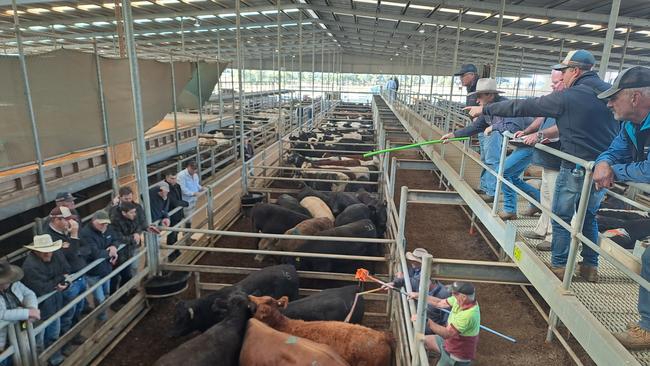Record numbers hit some saleyards as producers take the money
One of Victoria’s saleyards saw the biggest fortnightly prime sale in more than a decade on the back of rain and price jump earlier this week.

Saleyards have become awash with cattle, as producers opt for money now rather than risk feeding through the winter for an uncertain return.
Store cattle numbers ballooned to 4500 at Wodonga today, the bulk of the offering being young spring drop calves.
Supplies are anticipated to go even higher at Leongatha tomorrow (Friday), with around 6000 head expected to fill the centre.
It follows on from a big week at prime markets with multiple saleyards reporting spikes in supply as producers cash-in cattle after prices strengthened on the back of flooding rains across parts of Queensland and NSW.
Echuca on Wednesday had its biggest fortnightly prime sale in more than a decade, saleyard
manager James Ryan advised after being prompted to look back through records after 15,550 cattle filled the centre to capacity.
Gippsland agent Anthony Delaney, Delaney Livestock and Property, said the industry seemed to be in a midst of another wave of selling.
“There is cattle everywhere at the moment,’’ he said: “People that had held onto cattle are now chasing the market for that bit better money which is now on offer, particularly as we are on the cusp of winter.’’
North East Victorian agent Gordon Perkins, Corcoran Parker Wodonga, said many producers were still uneasy about the beef market after a rollercoaster ride in recent months that hit very low price points.
He said it appeared to be a factor in decision making now as young calves were sold ahead of the winter.
“People with spring drop calves in the 250-300kg range are saying we will take the $1000 to $1200, as it is either that or wear the cost of feeding hay through the winter and not knowing what they will be worth at the other end.’’
The pressure of numbers is starting to hold price movements, with most sales either just holding at recent improved levels or slightly cheaper.
In fact the Eastern Young Cattle Indicator has ease 1/ckg in trading today, sitting now at 625c/kg, after a quick jump at the start of the week.
Agents said any plainer cattle were starting to feel the impact of restockers having a lot of choice.
At Wodonga today the key price outcomes across the 4500 head yarding were:
863 steer calves, 200-280kg, sold to 470c and averaged 376c or $928 per head;
656 steers 280-330kg sold to 418c and averaged 368c/kg or $1120; and
473 steers 330-400kg averaged 329c or $1198.
For heifers the results were:
804 small heifers 200-280kg averaged 280c or $675
371 heifers 280-330kg averaged 271c or $821; and
273 heifers 330-400kg averaged 273c or $973 per head.
The data shows the influx of lighter weight and younger calves.
Meanwhile, bull sales have benefited from the rain.
Mansfield-based Riga Angus sold 36 from 43 offered yesterday to a top of $19,000 (bought by a Benalla commercial breeder) and a solid average of $7583.
Co-principal Tim Finger said recent rain “definitely helped with the result, it was better than expected”.
“Cattle prices are interesting to keep an eye on at the moment, hopefully they really rebound but I’m hearing that it may not be until later next year,” he said.
While the Mansfield area has received around 45mm in the past fortnight, many grazing regions in South Western Victoria remain on the look out for decent falls with some areas having had less than 10mm in the same period.


